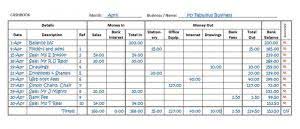Double Declining Balance Method Formula How to Calculate

Notice in year 5, the truck is only depreciated by $129 because you’ve reached the salvage value of the truck. Our goal is to deliver the most understandable and comprehensive explanations of financial topics using simple writing complemented by helpful graphics and animation videos. This team of experts helps Finance Strategists maintain the highest level of accuracy and professionalism https://www.bookstime.com/ possible.
- In that case, we will charge depreciation only for the time the asset was still in use (partial year).
- As these examples show, the DDB method can be particularly useful for depreciating assets that have a rapid decline in efficiency, effectiveness, or relevance.
- This method falls under the category of accelerated depreciation methods, which means that it front-loads the depreciation expenses, allowing for a larger deduction in the earlier years of an asset’s life.
- Unlike DDB, the straight-line method spreads the depreciation of an asset evenly over its useful life.
- If you purchased a truck for delivery of your goods from one place to another, look at how you will be using the truck to sell the goods.
- Accelerated depreciation is any method of depreciation used for accounting or income tax purposes that allows greater depreciation expenses in the early years of the life of an asset.
What Assets Are DDB Best Used For?

Each year, as your assets get older and less efficient, their value decreases. Depreciation lets you record this decrease in value on your financial statements. It turns the initial cost of the asset into an ongoing expense, spread across the asset’s useful life, giving you a more accurate financial picture. Companies generally use a declining balance method or a straight-line method to calculate the value of depreciation of an asset. The double-declining approach has gained much popularity recently and is also known as the accelerated depreciation method or the reducing balance method. While most companies would look to avoid using the double declining balance method for depreciating their assets, some may still go with it.

Microsoft® Excel® Functions Equivalent: DDB
If something unforeseen happens down the line—a slow year, a sudden increase in expenses—you may wish you’d stuck to good old straight line depreciation. While double declining balance has its money-up-front appeal, that means your tax bill goes up in the future. Your basic depreciation rate is the rate at which an asset depreciates using the straight line method. The amount of final year depreciation will equal the difference between the book value of the laptop at the start of the accounting period ($218.75) and the asset’s salvage value ($200). Sara wants to know the amounts of depreciation expense and asset value she needs to show in her financial statements prepared on 31 December each year if the double-declining method is used. An exception to this rule is when an asset is disposed before its final year of its useful life, i.e. in one of its middle years.
Example of DDB Depreciation
- As time passes, the repairs and maintenance expense will rise, leading to lowered depreciation expense.
- They have estimated the machine’s useful life to be eight years, with a salvage value of $ 11,000.
- However, if the company chose to use the DDB depreciation method for the same asset, that percentage would increase to 20%.
- In a nutshell, depending on the nature of the assets and your company’s choice, you can pick one best-suited depreciation method.
The reason for not using it is that the method results in a lower net income in the early years of the asset’s life. To calculate the depreciation expense for the first year, we need to apply the rate of depreciation (50%) to the cost of the asset ($2000) does double declining balance use salvage value and multiply the answer with the time factor (3/12). First-year depreciation expense is calculated by multiplying the asset’s full cost by the annual rate of depreciation and time factor. The DDB method contrasts sharply with the straight-line method, where the depreciation expense is evenly spread over the asset’s useful life.


This method is faster than both the sum-of-the-years’ digits and straight-line methods. Apply this rate to the asset’s remaining book value (cost minus accumulated depreciation) at the start of each year. So https://x.com/BooksTimeInc if an asset with a 10-year life and no salvage value depreciates at 10% per year straight-line, the DDB rate would be 20%.
- Recovery period, or the useful life of the asset, is the period over which you’re depreciating it, in years.
- Various depreciation methods are available to businesses, each with its own advantages and drawbacks.
- In later years, as maintenance becomes more regular, you’ll be writing off less of the value of the asset—while writing off more in the form of maintenance.
- (An example might be an apple tree that produces fewer and fewer apples as the years go by.) Naturally, you have to pay taxes on that income.
- To create a depreciation schedule, plot out the depreciation amount each year for the entire recovery period of an asset.
- In this way, an organization can allocate reduced depreciation in later years.